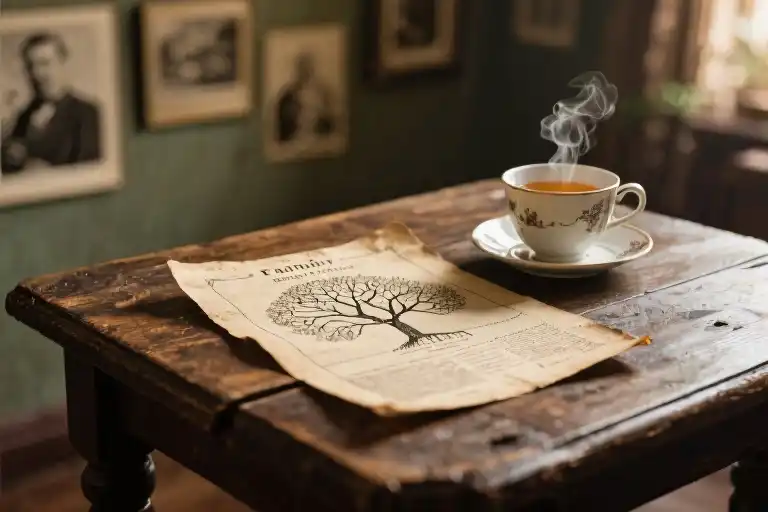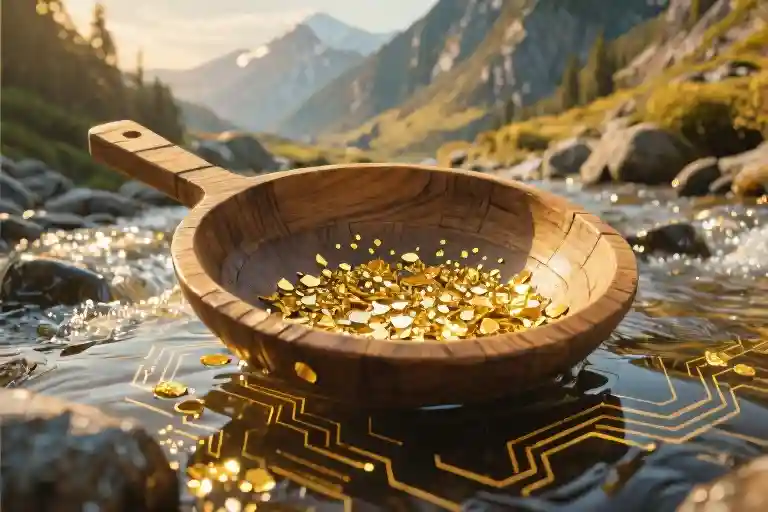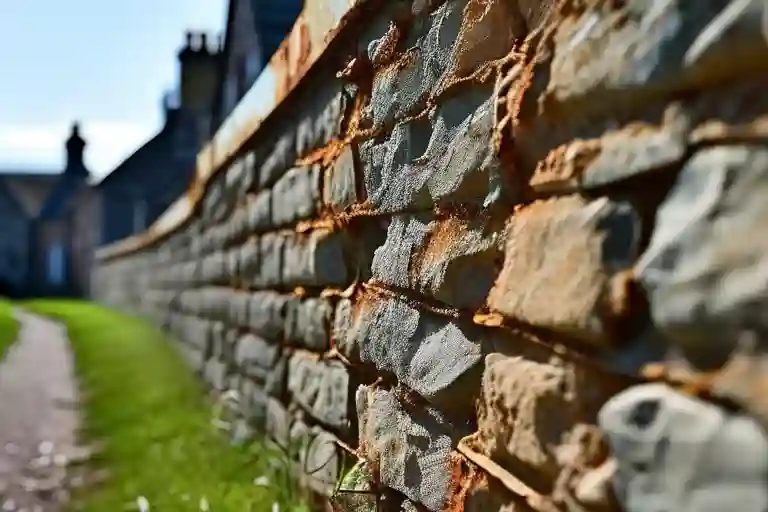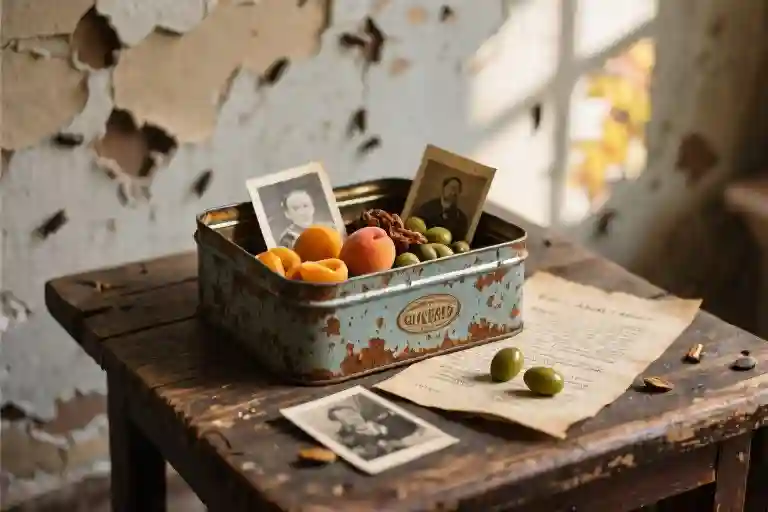My last name tells a story – not just about who I am, but about the generations that came before me. Crouch, an English surname with roots in the Anglo-Saxon word ‘Cruche,’ literally means ‘at the cross.’ This simple etymology paints a vivid picture of my ancestors standing at bustling medieval crossroads, perhaps running an inn where travelers exchanged goods and stories. It’s fascinating how a single word can connect me to people I’ll never meet, yet whose lives shaped mine in ways I’m still discovering.
Among these ancestors emerges a particularly colorful character – my distant relative who reinvented herself as Cora Pearl, becoming one of Paris’s most celebrated courtesans during the Belle Époque. Her story of self-reinvention at society’s margins whispers an unexpected truth: our family narratives often contain multitudes, contradicting simple origin myths we might prefer. This complexity makes our personal histories richer, more human.
But the Crouch name represents only half my heritage. On my Scottish side, the MacDonald clan embarked on an extraordinary journey in the late 1800s – arriving in Boston by ship, then walking the entire way to Cape Breton, Nova Scotia. When I first plotted their route on Google Maps, the distance took my breath away: over 700 kilometers, equivalent to walking a marathon every day for two weeks straight. What desperation or hope drove them to undertake such a journey? Their resilience lives in my bones, though I’ll never know their full story.
You might wonder why these ancestral tales matter in our fast-paced digital age. Here’s what I’ve come to understand: we’re not isolated individuals, but living archives of those who came before. Our genes carry biological memories, our traditions preserve cultural wisdom, and even our unconscious choices echo ancestral patterns. This realization birthed my concept of Deep Community – the understanding that meaningful belonging requires acknowledging these invisible threads connecting us across time.
Modern life often severs these connections. We change jobs every few years, move across continents, and curate digital personas detached from our roots. Yet something primal in us still yearns for what Deep Community offers: identity anchored in intergenerational continuity, responsibility that transcends our lifespan, and relationships that acknowledge our shared humanity. My ancestors’ stories – the innkeeper at the crossroads, the boundary-crossing courtesan, the determined Scottish migrants – all whisper the same truth: we’re part of something much larger than ourselves.
So I invite you to consider: what stories does your name carry? Not just the literal meaning (though that’s a fascinating starting point), but the lived experiences of those who passed it down to you. These stories matter more than ever in our age of shallow connections, offering wisdom for building communities with roots deep enough to weather our uncertain future.
The Bloodline at the Crossroads
My last name carries centuries of whispers in its syllables. Crouch—an unassuming English surname with Anglo-Saxon roots tracing back to ‘Cruche,’ meaning ‘at the cross.’ This linguistic breadcrumb suggests my ancestors were people of the crossroads, perhaps innkeepers offering ale and beds to weary travelers, or merchants trading goods where paths converged. There’s poetry in imagining them as facilitators of connection, their lives woven into the fabric of medieval community hubs.
The Etymology of Belonging
Surname origins often reveal forgotten chapters of social history. The occupational theory behind ‘Crouch’ aligns with research from the Oxford Dictionary of Family Names, which notes that many English surnames evolved from geographical features or trades. My ancestors’ presumed role as crossroads stewards mirrors modern community-building principles: creating spaces for exchange, offering hospitality, and reading the comings and-goings of human stories.
This etymological detective work does more than satisfy curiosity about family history—it anchors me to a tangible legacy. When I write about community building today, I’m unconsciously channeling generations of crossroad-keepers who understood the art of gathering people.
The Courtesan Who Rewrote Her Story
Among these ancestral threads, one shines particularly bright: Cora Pearl, born Eliza Emma Crouch, who transformed herself into 19th-century Paris’s most infamous courtesan. Beyond the scandalous headlines (her diamond-studded bath, her affairs with European nobility), Cora’s story fascinates me as an early example of personal rebranding and agency.
In an era when women had limited options, she turned societal constraints into a form of power, curating her identity with the precision of a modern influencer. Her emerald-green carriage drawn by white ponies wasn’t just extravagance—it was a calculated statement of visibility. While I don’t share her life choices, I admire her understanding of identity as something we actively shape, even when dealt difficult cards.
The Metaphor of Crossings
These fragments—the innkeepers and the courtesan—converge into a larger truth about identity and community. Crossroads aren’t just physical spaces; they’re moments of decision, reinvention, and connection. My ancestors’ lives at literal and metaphorical crossings hint at why I’m drawn to the concept of Deep Community today: it’s about creating modern-day crossroads where people can pause, exchange stories, and find belonging that spans generations.
As I trace the Crouch lineage through old parish records and yellowed letters, I realize surname research isn’t mere nostalgia. It’s an act of reclaiming our role in the human network—reminding ourselves that we’re never truly solitary, but always standing at some intersection of past and present, ready to welcome the next traveler.
The Walker’s Gene: An Epic Migration Story
My Scottish ancestors didn’t just move – they walked their way into history. In the late 1800s, a determined group of MacDonalds arrived in Boston by ship, only to embark on an even more extraordinary journey: a two-week trek on foot to Cape Breton, Nova Scotia. Today, we’d call this extreme backpacking – Google Maps calculates this route at approximately 650 kilometers, the equivalent of walking a marathon every single day through unfamiliar terrain.
The Road Less Traveled
Modern travelers making this trip would encounter:
- Urban landscapes transitioning to rugged coastal paths
- Unpredictable weather patterns across New England and Atlantic Canada
- Limited supplies compared to contemporary hiking infrastructure
Yet my ancestors carried children, tools, and hopes for new beginnings along what became our family’s foundational journey. Oral history fragments passed down through generations mention frozen boots thawed by campfires and shared meals with indigenous Mi’kmaq guides – fleeting moments of human connection that sustained them.
Why Walking Matters
This migration story represents more than physical endurance:
- Intergenerational resilience – The choice to walk rather than wait for transport reflects a mindset we’ve inherited
- Embodied connection – Their footsteps literally shaped our family’s relationship with the land
- Community interdependence – Survival required cooperation we rarely exercise today
As I retrace their route virtually, I’m struck by how modern mobility (planes, cars, digital nomadism) has erased the visceral understanding that geography shapes identity. Their walking created what we now call Deep Community – relationships forged through shared struggle and landscape memory.
The Stories We Carry
Three fragments from family lore:
- “Your great-great-grandmother wrapped the baby in her shawl when the snow came”
- “They traded a pocket watch for directions through the Annapolis Valley”
- “At night, they told stories of Scotland to remember why they left”
These aren’t just anecdotes – they’re living proof of how migration stories build cultural belonging. Unlike today’s transient lifestyles, their journey bound them irrevocably to the land and each other. When we research family migration history, we’re not just uncovering dates – we’re recovering the emotional DNA of our resilience.
Your Turn: Mapping Heritage
Try this exercise to connect with your ancestors’ journeys:
- Identify one pivotal migration in your family history
- Plot the route using modern mapping tools
- Research historical conditions during that period
- Note what survival skills they employed
As I’ve learned through documenting the MacDonald trek, these stories transform from dry facts into compass points for modern life. Their walking shoes left prints we still follow today – not just across geography, but through the landscapes of identity and belonging.
The Sum of Time
We often think of ourselves as isolated individuals, making our way through life independently. But the truth is far more profound – we are living archives, carrying within us the accumulated experiences of those who came before. This realization forms the foundation of what I call the four-dimensional identity: genetic, ethnic, cultural, and narrative inheritance.
The Living Archive
Our bodies themselves tell ancestral stories. Each strand of DNA contains molecular memories of survival strategies developed over millennia – from the ability to digest certain foods to immune responses shaped by ancient plagues. My Scottish ancestors’ genetic adaptation to colder climates still manifests in my own physiology today. This biological legacy connects us physically across generations in ways we’re only beginning to understand through modern genealogy tools like AncestryDNA and 23andMe.
Beyond biology, cultural transmission flows through family traditions, recipes, and even speech patterns. The lilt in my voice when pronouncing certain words unconsciously echoes my MacDonald forebears’ Gaelic-inflected English. The way we celebrate holidays, the superstitions we can’t quite shake, the bedtime stories we repeat – these form invisible threads tying us to people we’ve never met.
The Paradox of Modern Disconnection
Contemporary life, with its emphasis on individualism and digital connections, has created what sociologists call “social atomization.” Where our ancestors lived in tight-knit communities where everyone knew their family histories back generations, many of us struggle to name our great-grandparents. The erosion of intergenerational living arrangements means fewer opportunities for oral history transmission. We’ve gained mobility and independence, but at the cost of what psychologist Mary Pipher calls “the shelter of each other.”
This disconnection manifests practically. Without understanding our family medical histories, we miss crucial health insights. Losing touch with ancestral traditions leaves gaps in our cultural identity. Most profoundly, lacking knowledge of how our ancestors overcame hardships deprives us of psychological resources during our own challenges.
Reconstructing the Tapestry
Rebuilding these connections requires intentional effort in our fragmented world. Simple practices can begin restoring continuity:
- Create a family time capsule: Collect letters, recipes, and photographs with explanatory notes for future generations
- Map your migration story: Use tools like Google Earth to trace your ancestors’ journeys, making their sacrifices tangible
- Host living history dinners: Prepare ancestral dishes while sharing stories about the people who originally made them
- Establish interview traditions: Record conversations with older relatives using simple apps like StoryCorps
These acts of preservation transform abstract “relatives” into real people whose choices directly enabled our existence. When I look at my great-great-grandmother’s immigration papers, I don’t just see a historical document – I recognize an act of courage that made my life possible.
The Ripple Across Time
Understanding ourselves as temporal beings changes how we approach community building. If we acknowledge that our actions today will ripple across generations, we begin making different choices – prioritizing sustainability, preserving cultural knowledge, and investing in social structures that will endure. This long-term perspective lies at the heart of both deep ecology and meaningful community.
My ancestors’ journey from Scottish highlands to Canadian maritimes wasn’t just geographical – it was an act of faith in futures they wouldn’t live to see. Their story lives through me, just as mine will someday echo through descendants I’ll never meet. This continuity forms the deepest foundation of community – the recognition that we are all, quite literally, in this together across the expanse of time.
The Blueprint of Deep Community
What makes a community truly deep? After years of tracing my family’s journey from medieval crossroads to transatlantic migrations, I’ve come to define Deep Community as having three essential dimensions that distinguish it from superficial connections: historical consciousness, intergenerational reciprocity, and ecological embeddedness. Unlike your neighborhood Facebook group or condo association, these are communities where people don’t just coexist—they consciously choose to become stewards of shared pasts and futures.
The Three Pillars of Connection
- Historical Consciousness
In my grandmother’s village in Cape Breton, every potluck began with stories—not about celebrities or sports, but about whose great-uncle built the first schoolhouse, or which family donated the land for the church. This oral tradition created what sociologist Maurice Halbwachs called “collective memory,” where personal identity intertwines with communal history. When we know the struggles behind the streets we walk (like my ancestors’ 500km trek), ordinary spaces become sacred. - Intergenerational Reciprocity
The Scottish Gaelic phrase clann originally meant “children” but evolved to mean “clan”—a beautiful linguistic reminder that communities survive through their commitment to future generations. Modern examples like Norway’s Andel community demonstrate this through their “100-year decisions” policy, where all major infrastructure projects must be evaluated based on their century-long impact. Contrast this with most condo boards planning quarterly budgets. - Ecological Embeddedness
My Crouch ancestors living “at the cross” depended on knowing which travelers brought wool from Yorkshire and which carried spices from London—an early lesson in interconnected systems. Today’s Deep Communities, like Findhorn Ecovillage, take this further by designing wastewater systems that feed food forests, making the circle of resource flow visible and participatory.
Beyond Likes and Handshakes: A Comparison Matrix
| Dimension | Traditional Community (e.g., small town) | Virtual Community (e.g., Facebook group) | Deep Community |
|---|---|---|---|
| Time Depth | 2-3 generations | Present-moment focus | 7+ generations |
| Conflict Resolution | Gossip chains | Block/mute buttons | Restorative circles |
| Resource Flow | Hidden infrastructure | Digital transactions | Visible cycles (compost, skill shares) |
| Storytelling | Fragmented family lore | Viral memes | Intergenerational narrative projects |
The Norwegian Model: A Living Case Study
During my research in Hurdal Ecovillage (90 minutes from Oslo), I witnessed all three pillars in action. Their “time capsule” ritual—where residents bury letters for future inhabitants—embodies historical consciousness. The community’s “auntie/uncle system,” pairing elders with young families, operationalizes intergenerational care. Most strikingly, their decision to limit private cars wasn’t framed as sacrifice, but as “giving future children the gift of clean air.”
This contrasts sharply with the transient connections dominating modern life. As environmental philosopher Joanna Macy observes: “We’re treated as consumers, not creators—audience members rather than actors in the grand drama of our time.” Deep Communities reclaim that creative agency by asking: What will our descendants thank us for?
Your Turn: From Theory to Practice
Start small by introducing one Deep Community element into your existing circles:
- For family: Record elders describing childhood landscapes, then compare with current Google Earth images
- For workplaces: Initiate a “legacy project” that outlasts individual tenure (e.g., a mentorship archive)
- For neighborhoods: Map local history onto physical spaces (What grew here before the supermarket? Who walked these trails?)
Like my surname’s crossroads, every community stands at a junction between what was and what could be. The depth of our roots determines the reach of our branches.
The Wisdom of Deep Ecology
When we talk about building Deep Community, we’re essentially discussing how to extend our sense of belonging beyond superficial connections. This is where deep ecology offers profound insights. Developed by Norwegian philosopher Arne Naess in the 1970s, this environmental philosophy provides eight principles that surprisingly align with what makes communities thrive across generations.
The Eight Principles (Simplified for Community Builders)
- All life has intrinsic value – Not just human members, but the entire ecosystem supporting your community deserves respect
- Diversity strengthens – Different perspectives (age, culture, occupation) create resilient communities
- Humans aren’t special – We’re part of nature’s web, not its masters
- Economic growth ≠ flourishing – True community health measures wellbeing, not GDP
- Interconnectedness – Your ancestor’s farming choices affect your soil quality today
- Local solutions matter – Cookie-cutter approaches fail; learn from your bioregion’s history
- Long-term thinking – Make decisions considering seven generations ahead
- Action follows awareness – Knowing these obligates us to practice them
What struck me most during my graduate studies was Principle #7 – the “thousand-year thinking” concept. My Scottish ancestors who walked to Nova Scotia weren’t just escaping famine; they were planting roots for descendants they’d never meet. That’s the same mindset we need when designing neighborhood parks or community centers today.
Climate Crisis as Community Crucible
Modern migration patterns eerily mirror my ancestors’ journeys, but with climate displacement replacing economic hardship. Over 21 million people annually now relocate due to environmental factors (UNHCR data). This isn’t abstract – my cousin’s family left California after wildfires destroyed their town, resettling in our ancestral Cape Breton area.
Here’s where deep ecology meets practical community building:
- Displaced populations need more than shelter; they need cultural continuity (like how Gaelic persisted in Nova Scotia despite suppression)
- Receiving communities must expand their “we” concept beyond current residents
- Planning processes should incorporate indigenous land knowledge (Mi’kmaq elders helped my ancestors farm unfamiliar terrain)
From Philosophy to Front Porch
Applying these ideas doesn’t require academic expertise. Start small:
- Map your community’s ecological history – Where did original water sources run? What species disappeared?
- Host intergenerational story circles – Pair elders’ climate memories with youth’s future visions
- Design communal spaces for permanence – Plant oak trees that’ll shade grandchildren’s playgrounds
- Practice “ancestor imagination” – What would your great-grandparents advise about local water conservation?
When I walk the same coastline my MacDonald ancestors reached exhausted after their trek, I feel time compress. Their struggle to survive birthed my opportunity to thrive – and my choices now ripple toward futures I’ll never see. That’s the heart of Deep Community: recognizing we’re temporary stewards in an endless relay race, passing the baton of belonging.
Reflection: What’s one long-term project your community could start this year that would benefit people 100 years from now?
Your Story Laboratory: Unearthing Family Narratives
Now that we’ve journeyed through the philosophical landscapes of Deep Community and ancestral connections, it’s time to roll up our sleeves. This chapter transforms theory into tangible action with practical tools for exploring your family history and building meaningful intergenerational connections.
The Family Historian’s Toolkit
- Digital Archaeology with Ancestry.com
- Start with their surname origin tool (you’ll be surprised how many occupational surnames like ‘Crouch’ hide in plain sight)
- Use their migration pattern visualizations to trace potential routes your ancestors may have taken (bonus: compare with my MacDonald clan’s walking route from Boston to Nova Scotia)
- Pro tip: Cross-reference census records with old newspaper archives for colorful details about daily life
- 23andMe’s Story Mode
Beyond genetic percentages, their updated interface now shows:
- Historical events your ancestors likely witnessed (mine includes the Highland Clearances)
- Migration timelines with climate context (why my Scottish ancestors left during the Little Ice Age)
- Surprising DNA connections to modern communities
- Google Earth Time Travel
- Overlay historical maps onto modern landscapes (seeing my ancestor’s inn location at a medieval crossroads explained so much)
- Calculate walking distances between ancestral homes (our modern car-brain can’t comprehend two-week treks)
- Document findings using their storytelling feature to create shareable family journey maps
The Three-Generation Story Swap
Hosting an intergenerational narrative exchange requires more nuance than simply recording elders’ memories. Here’s my tested framework:
Phase 1: Preparation
- Send prompt cards in advance:
▶ For grandparents: “What childhood smell/taste/song transports you?”
▶ For parents: “What family myth do you want investigated?”
▶ For kids: “What future ancestor would you like to be?”
Phase 2: The Gathering
- Begin with object-based storytelling (everyone brings one meaningful heirloom)
- Use the “Yes, and…” improv technique to build on each other’s memories
- Record not just facts but sensory details – the texture of a 1950s school desk, the sound of a particular dialect
Phase 3: Legacy Creation
- Co-create a family “time capsule” with:
▸ Digitized photos annotated with VoiceNotes
▸ A collective letter to future descendants
▸ A playlist of era-specific music mentioned in stories
Join the #MyDeepCommunity Movement
Your family narratives deserve more than dusty albums. Share them as living testaments to our interconnectedness:
- Instagram Challenge: Post a side-by-side of an ancestor’s story and how it manifests in your life today (e.g., “My great-grandmother’s resilience during migration → my climate activism”)
- TikTok Oral History: Film a elder telling one story three ways – in their native language, in English, and with emoji subtitles (the viral #GrandmaTranslates trend proves Gen Z craves this)
- Community Mapping: Use our open-source template to chart how your family’s journey intersects with historical events (many participants discover surprising neighbor connections)
Remember what we uncovered earlier – you’re not just researching names and dates. You’re reconstructing the Deep Community that made your existence possible. That innkeeper ancestor who welcomed travelers? They practiced radical hospitality. Those walking ancestors? They embodied sustainable travel before it was trendy. Now it’s your turn to honor their legacy by weaving these threads into our collective future.
“The stories we excavate become foundations for the communities we build.”
Share your discoveries with #MyDeepCommunity
The Crossroads We Carry
Every surname is a compass pointing to forgotten crossroads. As we conclude this journey through the Crouch lineage and the concept of Deep Community, let’s return to that fundamental metaphor – the crossing point where paths converge, choices are made, and directions are set. My ancestors’ lives unfolded at literal and metaphorical crossroads: market intersections where travelers met, ocean crossings between continents, and the social crosscurrents navigated by figures like Cora Pearl.
Where Your Story Intersects History
Your family name – whether Smith, García, Patel, or Nguyen – carries similar hidden maps. Consider:
- Geographical crossings: Migration routes that brought your ancestors to their present home
- Cultural intersections: Moments where traditions blended or clashed
- Personal turning points: Ancestral decisions that rippled through generations
“What crossroads does your surname commemorate?” This question isn’t merely genealogical curiosity – it’s the first step toward building Deep Community. When we understand how historical forces shaped our families, we gain empathy for how they shape others’ narratives too.
Resources for Your Journey
For those inspired to explore further:
Family History Tools
- Ancestry.com (DNA testing and historical records)
- FamilySearch (Free genealogical archives)
- StoryCorps (Preserving oral histories)
Deep Ecology Readings
- A Sand County Almanac by Aldo Leopold
- The Ecology of Wisdom by Arne Naess
- Braiding Sweetgrass by Robin Wall Kimmerer
Community Building
- The Art of Gathering by Priya Parker
- On Being Project (Conversations about meaningful connection)
The Path Forward
As you leave these digital pages, remember: you walk not alone, but with generations at your back and communities at your side. The Deep Community we build today becomes the ancestral legacy of tomorrow. What stories will they tell about the crossroads we’re navigating now? The answer begins with the simple act of asking an elder: “Where did we come from, and what should we carry forward?”
Your story – and your community’s story – is still being written at history’s great crossing point.




